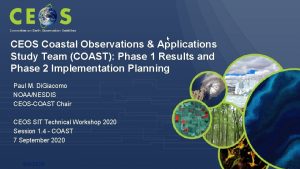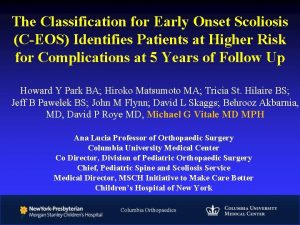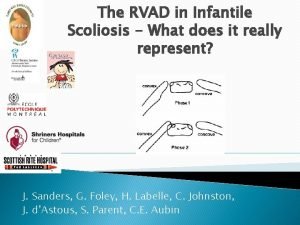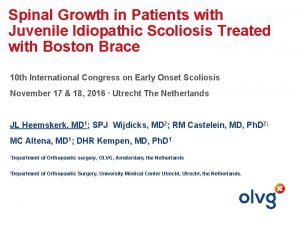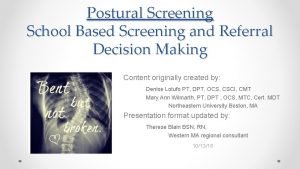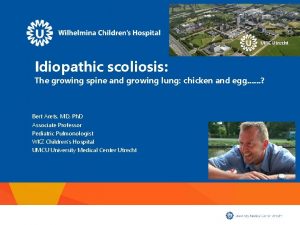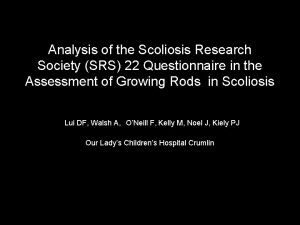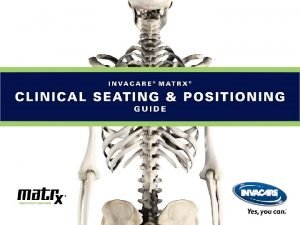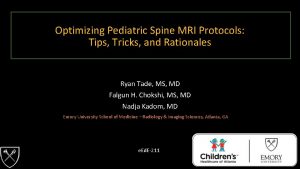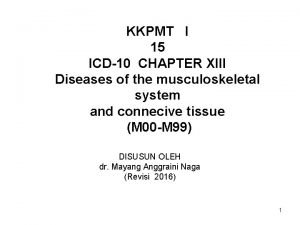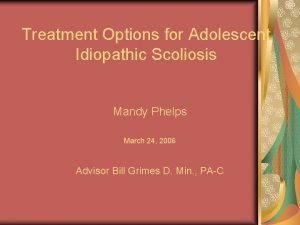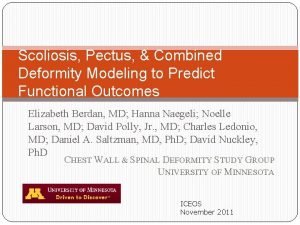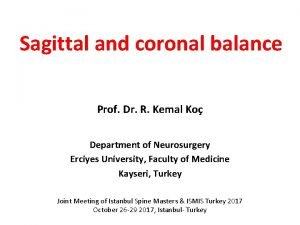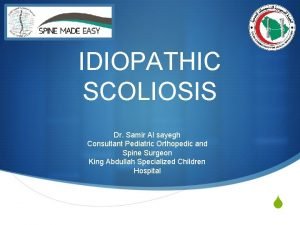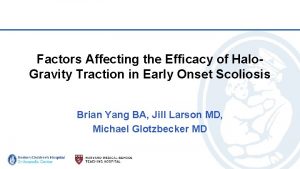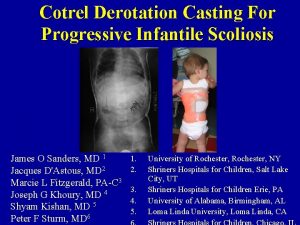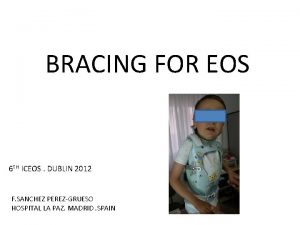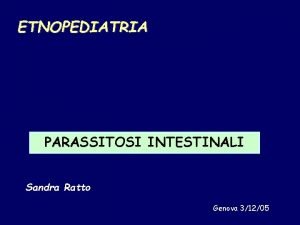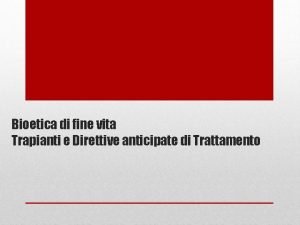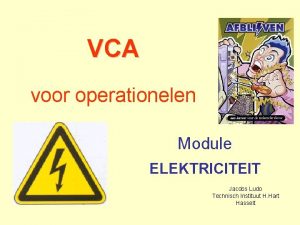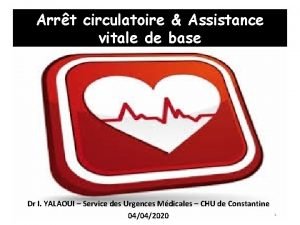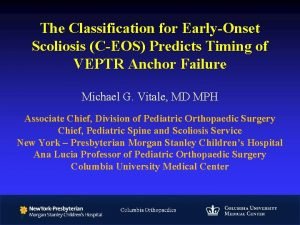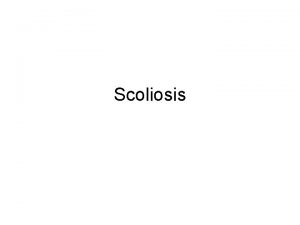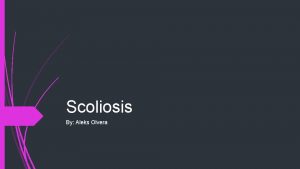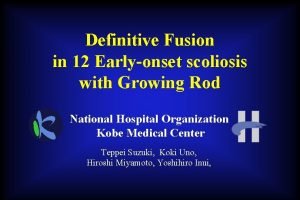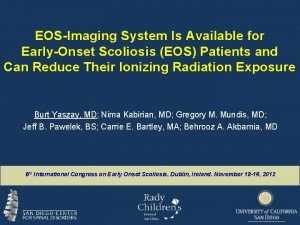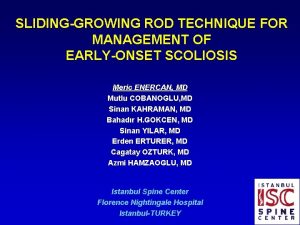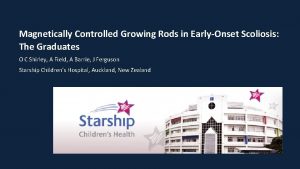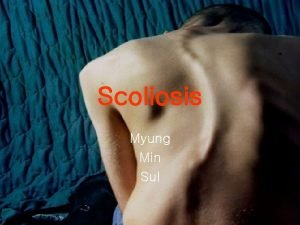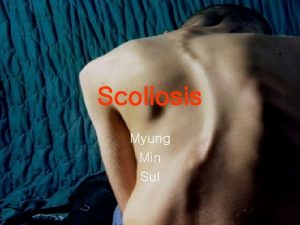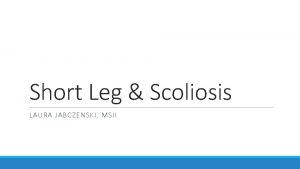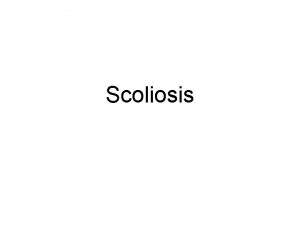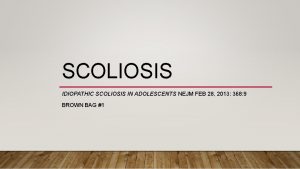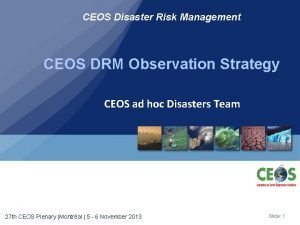CEOS Classification for EarlyOnset Scoliosis Michael G Vitale


































- Slides: 34

C-EOS Classification for Early-Onset Scoliosis Michael G. Vitale MD MPH Co Director, Division of Pediatric Orthopaedics Chief , Pediatric Spine and Scoliosis Service Ana Lucia Professor of Orthopaedic Surgery Children’s Hospital Of New York Columbia University Medical Center

Development and Initial Validation of a Novel Classification System for Early Onset Scoliosis Brendan A. Williams MD, Hiroko Matsumoto MA, Daren J. Mc. Calla MD, Behrooz A. Akbarnia MD, Laurel C. Blakemore MD, Randal R. Betz MD, John M. Flynn MD, Charles E. Johnston MD, Richard E. Mc. Carthy MD, David P. Roye Jr. MD, David L. Skaggs MD, John T. Smith MD, Brian D. Snyder MD Ph. D, Paul D. Sponseller MD MBA, Peter F. Sturm MD, George H. Thompson MD, Muharrem Yazici MD, Michael G. Vitale MD MPH Accepted to JBJS 2013

-Disclosures. Michael G. Vitale, MD MPH Columbia University Medical Center Disclosure: I DO have a financial relationship with a commercial interest. Royalties: Biomet Consultant: Stryker, CWSDSG, Biomet Research Support: OREF, CWSDRF, SRS, POSNA Divisional Support: OREF Travel Expenses: CWSDSG, Fox. PSDSG Other: CWSDSG - BOD POSNA BOD

Improving the Evidence Base in EOS Development of a Research Infrastructure Via five parallel efforts Endpoints Development/Validation of a Disease-Specific Qo. L Measure -- EOSQ Equipoise Identifying Clinical Equipoise in the Field of EOS Classification-EOS Development / Validation of Classification for EOS Complications Classification Standardize Way We Define and Report Complications Clinical Trials Proximal Anchors: Rib Vs Spine – Retrospective (Prospective Underway) Columbia Orthopaedics

Purpose of the Classification for EOS (C-EOS) To classify EOS patients in order to: 1) Predict the disease course of individual patients 2) Prognosticate and determine beneficiaries of differing treatment modalities 3) Improve communication among EOS providers and facilitate research

Key ‘Philosophical’ Aspects of the (C-EOS) • Comprehensive Applicable to all EOS pts • Practical Utilized in daily practice • Prognostic Predictive of course • Guide Informs treatment decisions An EOS ‘One Liner’

Methods: Validation Pathway Interviews, Literature Review and Working Session Reliability Testing Nominal Group Technique: Iterative Surveying and Group Discussion Future Work Audige L et al. (2005). A concept for the validation of fracture classifications. J Orthop Trauma. 19: 404 -409

Iterative Survey & Group Discussion Iterative Survey Group Discussion Proposing Variables Assessing Variables Finalizing Variables • POSNA – May 2011 • May-July 2011 • ICEOS – November 2011 Iterative input by 24 surgeons

Results of Variable Identification Survey COBB ETIOLOGY KYPHOSIS AGE PROGRESSION CHEST WALL ABNORMALITIES FLEXIBILITY OTHER CO-MORBIDITIES PULMONARY FUNCTION AMBULATORY ABILITY NUTRITIONAL STATUS MENTAL FUNCTION BONE QUALITY Not Useful Essential Useful 0 1 14 0 3 12 0 4 11 5 0 10 3 5 7 0. 87 0. 60 0. 47 0. 33 -0. 07 Sum of Ranks 29 27 26 20 19 CVR 2 9 4 -0. 47 17 4 3 3 2 5 10 11 6 8 9 12 8 5 4 3 1 2 0 0 -0. 33 -0. 47 -0. 60 -0. 87 -0. 73 -1. 00 16 16 15 14 12 5 4

C-EOS Variables: Etiology • Challenging variable due to heterogenous population • Numerous iterations based on study group feedback Etiology Flexible Rigid (R) Congenital Idiopathic Syndromic Idiopathic HTNM NM LTNM Syndromic Congenital Structural (F) Curve Columbia Orthopaedics

C-EOS Variables: Etiology Congenital/Structural Neuromuscular Syndromic Idiopathic Congenital/Structural: Curves developing due to a structural abnormality/asymmetry of the spine and/or thoracic cavity (i. e hemivertebrae, fused ribs, postthoracotomy, or CDH) Neuromuscular: Patient with neuromuscular disease (ie. SMA, Cerebral Palsy, muscular dystrophies, etc. Syndromic: Syndromes with known or possible association with scoliosis (including spinal dysraphism) Idiopathic: No clear causal agent (can include children with a significant co-morbidity that has no defined association with scoliosis)

C-EOS Variables: Cobb Angle (Major Curve) 1: <20º 2: 21 -50º 3: 51 -90º 4: >90º Cobb Angle: Measurement of major spinal curve in position of most gravity

C-EOS Variables: Kyphosis Maximum Total Kyphosis (-) <20º N: 21 -50º (+): >50º Maximum Total Kyphosis: Between any two levels throughout spine

C-EOS Variables: Progression Modifier (Optional) P 0: <10º/yr P 1: 10 -20º/ yr P 2: >20º/yr Minimum of 6 months x-ray follow-up [Cobb at t 2] – [Cobb at t 1] x 12 months /year [Months between t 1 and t 2]

C-EOS Finalized Etiology Highest Lowest Priority Cobb Angle (Major Curve) Congenital/Structural 1: <20º Neuromuscular 2: 21 -50º Syndromic 3: 51 -90º Idiopathic 4: >90º Etiology (In order of priority): Congenital/Structural: Curves developing due to a structural abnormality/asymmetry of the spine and/or thoracic cavity; includes hemivertebrae, fused ribs, post-thoracotomy, or CDH. Neurmuscular: Pts with neuromuscular disease Syndromic: Syndromes with known or possible association with scoliosis (including spinal dysraphism) Idiopathic: No clear causal agent (can include children with a significant co-morbidity that has no defined association with scoliosis) Maximum Total Kyphosis Progression Modifier (optional) (-) <20º P 0: <10º/yr N: 21 -50º P 1: 10 -20º/ yr (+): >50º P 2: >20º/yr Cobb Angle: Measurement of major spinal curve in position of most gravity Maximum Total Kyphosis: between any 2 levels Annual Progression Ratio Modifier (optional): Progression per year; min. 6 months between observation (Cobb @ t 2) – (Cobb @ t 1) X 12 months [t 2 -t 1]

CASE 1 History: • 19 mo old female • 38 wk, C-section • L thoracotomy for PDA repair @ 4 mo, scoliosis noted post-op • Acquired rib fusion b/w concave 4 th-5 th rib Physical: • Hypotonic UE and trunk, hypertonic LE • Rigid right thoracic curve C 7 -T 6 = 24º 9 months later Post-PDA surgery

CASE 1: 9 months later T 1 -T 8 = 42º 1. Etiology • Acquired chest wall deformity Congenital/structural 2. Cobb Angle • 42º 2 3. Kyphosis • Lateral x-ray reveals 35º maximum total kyphosis N 4. Progression Modifier (optional) • [(42º-24º)/(9 mo. )]x 12=24º/yr P 2 C/2/N/P 2 Etiology Congenital/ Structural Neuromuscul ar Cobb Angle (Major Curve) 1: <20º Maximum Total Kyphosis (-) <20º P 0: <10º/yr N: 21 -50º P 1: 10 -20º/ yr (+): >50º P 2: >20º/yr 2: 21 -50º Syndromic 3: 51 -90º Idiopathic 4: >90º Progression Modifier (optional)

CASE 2 History • 4 y/o girl w/ Congenital Myotonic Dystrophy • Mother as well Physical • Hyperkyphosis • Bilateral equinus s/p percutaneous heel lengthening – 30º of dorsiflexion • Full ROM at knees and hips

CASE 2 C 7 -L 4 = 50º 1. Etiology • Congenital? Neuromuscular? Syndromic? Kyphosis = 96 º • Cobb Angle • 50º 2 1. Kyphosis • 96º + 2. Progression Modifier (optional) • Not available N/2/+ Etiology Congenital/ Structural Neuromuscul ar Cobb Angle (Major Curve) 1: <20º Maximum Total Kyphosis (-) <20º P 0: <10º/yr N: 21 -50º P 1: 10 -20º/ yr (+): >50º P 2: >20º/yr 2: 21 -50º Syndromic 3: 51 -90º Idiopathic 4: >90º Progression Modifier (optional)

CASE 3 History Physical • 4 y/o girl w/ Pena. Shokeir Syndrome • Lays comfortably on table • Developmentally delayed • Right hip dislocation • Nonambulatory • Wheelchair • Stiff left thoracolumbar curvature • Rib cage rests on pelvis • Multiple contractures

CASE 3 T 9 -L 4= 88º Coronal Cobb= 97º Kyphosis= 26º 7 months later Etiology Congenital/ Structural Neuromuscul ar Cobb Angle (Major Curve) 1: <20º Maximum Total Kyphosis (-) <20º P 0: <10º/yr N: 21 -50º P 1: 10 -20º/ yr (+): >50º P 2: >20º/yr 2: 21 -50º Syndromic 3: 51 -90º Idiopathic 4: >90º Progression Modifier (optional)

CASE 4 1. Etiology • Pena-Shokier Syndrome Syndromic 97º 2. Cobb Angle • 97º 4 26º 7 months 88º 3. Kyphosis • 26º N 4. Progression Modifier (optional) • [(97º-88º)/(7 mo. )]x 12=15. 4º/yr P 1 S/4/N/P 1 Etiology Congenital/ Structural Neuromuscul ar Cobb Angle (Major Curve) 1: <20º Maximum Total Kyphosis (-) <20º P 0: <10º/yr N: 21 -50º P 1: 10 -20º/ yr (+): >50º P 2: >20º/yr 2: 21 -50º Syndromic 3: 51 -90º Idiopathic 4: >90º Progression Modifier (optional)

Methods: Validation Pathway Interviews, Literature Review and Working Session Reliability Testing Future Work Nominal Group Technique: Iterative Surveying and Group Discussion Audige L et al. (2005). A concept for the validation of fracture classifications. J Orthop Trauma. 19: 404 -409 Columbia Orthopaedics

The Classification for Early-Onset Scoliosis (C-EOS) Predicts Timing of VEPTR Anchor Failure Purpose: To assess C-EOS’ ability to prognosticate outcomes in a clinical setting Hypothesis: Timing to VEPTR fixation failure will differ among C-EOS classes

Methods Design: – Retrospective review of prospectively enrolled patients • Sourced from a national registry, Chest Wall Spinal Deformity Study Group (CWSDSG) Participants: Enrollees of the CWSDSG from 2005 -2011 – Inclusion • • EOS diagnosis >2 yrs follow-up VEPTR surgery patients Experienced VEPTR proximal fixation failure

Methods Endpoints: – Time (months) to VEPTR proximal fixation failure • Definition: Radiographic diagnosis of failure by an EOS surgeon requiring operative revision of the rib cradle Inclusion: – Of 446 VEPTR patients with adequate follow up, – 105 with proximal fixation failure Statistical Analysis: – Analysis of Variance (ANOVA) for solitary C-EOS variables – Kaplan-Meier Survivorship Analysis by C-EOS classes w n>3

Neuromuscular Pts Exhibit Rapid Failure ANOVA -NM vs. Idiopathic (p=. 026) -NM vs. Congential (p<. 001)

C-EOS Stratifies Low, Medium, and High Risk

Low Risk of Failure by C-EOS Low Risk • Congenital / Curve: 51 -90 ° / Hypokyphotic • C 3 -

Medium Risk of Failure by C-EOS Medium Risk: • Congenital/51 -90° / Norm & Hyper- kyphosis • C 3 N, C 3+ • Neuromuscular / 51 -90° / hyperkyphosis • N 3+

High Risk of Failure by C-EOS High Risk: • Neuromuscular / Curve 5190° & >90° / Norm & hyperkyphosis • N 3 N, N 4+

Conclusions 1. C-EOS able to stratify risk of rapid VEPTR anchor failure • • Supports validity of C-EOS instrument Potential for use in clinical setting 2. Neuromuscular etiology and curves > 90 as individual variables at high risk of rapid anchor failure 3. With further study, C-EOS may guide treatment decisions and inform providers

Work in Progress Associate C-EOS with Patient Outcome C-EOS applied to min. 5 Yr follow up pts: • Purpose: Apply C-EOS to identify trends • Methods: – Retrospective review of CWSDSG & GSSG database – Min 5 year follow-up • Endpoints: – Complications – Change in coronal and sagittal curve over time • Status: Pending data collection from CWSDSG and GSSG Registry

Thank You Michael G. Vitale, MD MPH mgv 1@columbia. edu
 Steve labahn
Steve labahn Ceos coast
Ceos coast Early onset scoliosis classification
Early onset scoliosis classification Michael g vitale, md
Michael g vitale, md Rib vertebral angle
Rib vertebral angle Scoliosis chiropractor seminole county
Scoliosis chiropractor seminole county School spinal screening worksheet
School spinal screening worksheet Scoliosis
Scoliosis Scoliosis research society
Scoliosis research society Hyperextesion
Hyperextesion Mri scoliosis protocol
Mri scoliosis protocol Disorder of synovium and tendon
Disorder of synovium and tendon Disorder of synovium and tendon
Disorder of synovium and tendon Infantile scoliosis casting
Infantile scoliosis casting Scoliosis advisor
Scoliosis advisor Rib hump scoliosis
Rib hump scoliosis Horizontal
Horizontal Scoliosis advisor
Scoliosis advisor Factors affecting traction
Factors affecting traction Derotation cast
Derotation cast Turnbuckle cast scoliosis
Turnbuckle cast scoliosis Transfusion en urgence vitale immédiate
Transfusion en urgence vitale immédiate Engel v vitale precedent cases
Engel v vitale precedent cases Vertebrati acquatici con imbuto boccale
Vertebrati acquatici con imbuto boccale Deambulatorio san vitale
Deambulatorio san vitale Dr gary vitale louisville ky
Dr gary vitale louisville ky Ciclo vitale dell'ape scuola primaria
Ciclo vitale dell'ape scuola primaria Etnopediatria
Etnopediatria Engel v vitale precedent
Engel v vitale precedent Ciclo vitale dell'uomo
Ciclo vitale dell'uomo Tripode vitale di bichat
Tripode vitale di bichat Vitale 5 elektriciteit
Vitale 5 elektriciteit Società chiuse e aperte bergson
Società chiuse e aperte bergson Intran3
Intran3 Assistance vitale de base
Assistance vitale de base

